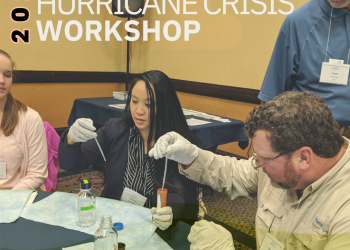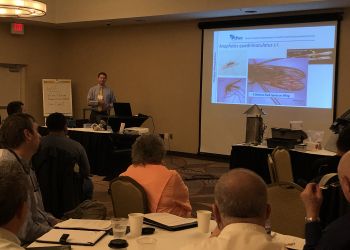This blog post was written by Charlotte Ciampa, Communications Intern for the Environmental Health team at NACCHO. Charlotte is a senior at Emmanuel College in Boston, MA, majoring in Communications and Media Studies with minors in Marketing and Global and Public Health.
Local, territorial, and state health departments everywhere felt the effects of the COVID-19 pandemic, with each department bearing a different weight of the burden. While all public health services were affected drastically, environmental health service teams within local health departments (LHDs) bore a heavy majority of the burden.
Direct Effects of the Pandemic on Environmental Health Local Staff
LHDs work every day to have resources readily available for public health emergencies like COVID-19, however, staff shortage and funding often prohibits the emergency response from being as effective as is needed by the community. About 76% of LHDs reported that they did not have enough staff to serve what the pandemic called for, 56% reported inconsistent guidance from the federal government, 50% reported inconsistent guidance from the state government, and 47% reported a lack of dedicated funding. This called for more exertive efforts by teams within the LHD such as environmental health.
Environmental health staff make up 12% of the LHD workforce, providing a wide array of important services such as food safety education, vector control, indoor air quality, hazmat response, land use planning, air pollution, radiation control, and noise pollution. Eighty four percent of all surveillance for all local health departments is provided by environmental services.
These vital services were halted when the COVID-19 pandemic began focusing instead on necessary emergency services that the pandemic called for. Like many public health services provided by LHDs, they became secondary to the frontline response to the pandemic. One of these services, environmental health inspections, was reduced by 48% from 2019 to 2020. NACCHO found that environmental health workers had the highest percentage among all of the LHD workforces reassigned to respond to the pandemic - at 57% reassignment.
On top of the work environmental health teams faced, the mental toll of the workforce was like none ever seen before. Many public health workers reported experiencing symptoms of depression, anxiety, PTSD, and suicidal ideation. The prevalence of symptoms of mental health conditions had increased by 40.9% in 2021. Symptoms such as depression and anxiety were found among public health workers at similar rates to those seen in healthcare workers while symptoms of PTDS were 10-20% higher in public health workers than those reported in healthcare workers. The traumatic and stressful workload taken on by LHDs during the pandemic had a direct impact on these rates, exacerbated in cases by the harassment faced by health departments at the time; NACCHO reported that almost one in six local health staff agreed that they “felt bullied, threatened, or harassed by individuals outside of the health department because of [their] role as a public health professional.”
Replenishing the Workforce
One of the most important steps that can be taken now in recovery is focusing on replenishing the workforce. The public health workforce was experiencing a decline even before the COVID-19 pandemic recording a decrease of 15% over the last decade, and this has only been exacerbated since the pandemic. An analysis of state and local health departments found that these departments “need to hire a minimum of 80,000 more full-time equivalent positions (FTEs) — an increase of nearly 80% — to provide adequate infrastructure and a minimum package of public health services.”
Six strategies to replenish to U.S. public health workforce as suggested in this McKinsey & Company article are:
- Define the role of public healthcare workers as a necessity and lay out specific capabilities and duties.
- Redefine resourcing needs between departments, and share both talent and tangible resources with partners.
- Modernize the recruitment process to appeal to the new workforce, attracting new talent and skills through digital and analytically driven platforms.
- Invest in employees through a clear definition of the company culture, regular reassessment of employee needs, and allocate funds to contribute to a stable work environment. Further investment in employees through skill training and opportunities for growth are also important.
- Foster strong leadership skills within the workforce through training for existing employees, external recruitment, and cultivating environments where all employees can grow.
- Promote a workforce that values diversity, equity, and inclusion to rebuild trust in the community as well as combat the long-standing inequities that have existed within the public health sphere.
Resources That Can Help
The workforce does not just need replenishment in terms of staffing, but also in terms of morale. Here are some resources that can help LHDs:
- NACCHO’s Public Health Workforce Resilience Resource Library
- NACCHO’s full list of resources for the public health workforce to maintain health and well-being during a public health crisis.
- NACCHO’s Joy in Work Toolkit
- NACCHO has adapted the Institute for Healthcare Improvement Framework for Improving Joy in Work to meet the needs of the local governmental public health workforce.
- NACCHO University (An online education and training resource to develop knowledge and competencies for local public health)
- Suggested courses:
- Building Workforce Resilience through the Practice of Psychological First Aid: A Course for Leaders and Teams
- Once the Pandemic is Gone, How Can Public Servants Tackle the Mental Health Crisis
- GROW! Leadership Academy – A Public Health Workforce Development Program for Emerging Leaders
- Using Data to Rethink Preparedness Systems and Policies for Resiliency and Equity
- Suggested courses:
- Agency for Toxic Substances and Disease Registry’s Community Stress Resource Center
- This resource provides guidance and tools for dealing with stress and building resilience within communities during public health responses to environmental hazards.





